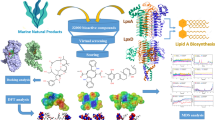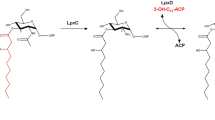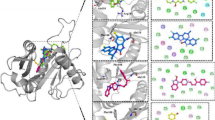Abstract
Pseudomonas aeruginosa is an opportunistic human pathogen. It synthesizes the poison called Hydrogen Cyanide (HCN). The synthesis of HCN is mediated by the enzyme HCN synthase which is obtained from the hcnABC operon and the transcription of the hcnABC operon is mediated by three proteins LasR, RhlR, and ANR. In our previous works, we analyzed the activation process of RhlR and LasR proteins by their cognate auto-inducer ligands (N-butanoyl-l-homoserine lactone and N-(3-oxododecanoyl)-homoserine lactone respectively). In this work, we attempted to identify some multi-targeting ligands which would be able to destroy the structural integrity of both the RhlR and LasR proteins using steered MD simulations. We used the virtual screening of ligand libraries, and for that purpose, we used the NCI drug database. We selected the top 4 ligands from our virtual screening experiments. We then tried to check their relative binding affinities with the LasR and RhlR proteins in comparison to their native auto-inducer ligands. Through this work, we were able to identify 4 such ligands which were capable of binding to both the RhlR and LasR proteins in a better way than their native auto-inducer ligands. The efficacies of these ligands to actually perturb the structural integrity of RhlR and LasR proteins could be tested in wet lab. The work is the first work in the field of structure-based drug design to come up with possible multi-targeting drug-like structures against the RhlR and LasR proteins from Pseudomonas aeruginosa.




Similar content being viewed by others
Data availability
The data are available on request.
References
Al-Wrafy F, Brzozowska E, Górska S, Gamian A (2017) Pathogenic factors of Pseudomonas aeruginosa - the role of biofilm in pathogenicity and as a target for phage therapy. Postepy Hig Med Dosw(Online) 71(1):78–91. https://doi.org/10.5604/01.3001.0010.3792
Sass G et al (2018) Studies of Pseudomonas aeruginosa mutants indicate pyoverdine as the central factor in inhibition of Aspergillus fumigatus biofilm. J Bacteriol 200:1. https://doi.org/10.1128/JB.00345-17
Lister PD, Wolter DJ, Hanson ND (2009) Antibacterial-resistant Pseudomonas aeruginosa: Clinical impact and complex regulation of chromosomally encoded resistance mechanisms. Clin Microbiol Rev 22(4):582–610. https://doi.org/10.1128/CMR.00040-09
Sadikot RT, Blackwell TS, Christman JW, Prince AS (2005) Pathogen-host interactions in pseudomonas aeruginosa pneumonia. Am J Respir Crit Care Med 171(11):1209–1223. https://doi.org/10.1164/rccm.200408-1044SO
Gallagher LA, Manoil C (2001) Pseudomonas aeruginosa PAO1 kills Caenorhabditis elegans by cyanide poisoning. J Bacteriol 183(21):6207–6214. https://doi.org/10.1128/JB.183.21.6207-6214.2001
Wang M, Schaefer AL, Dandekar AA, Greenberg EP (2015) Quorum sensing and policing of Pseudomonas aeruginosa social cheaters. Proc Natl Acad Sci U S A 112(7):2187–2191. https://doi.org/10.1073/pnas.1500704112
Pessi G, Haas D (2000) Transcriptional control of the hydrogen cyanide biosynthetic genes hcnABC by the anaerobic regulator ANR and the quorum-sensing regulators LasR and RhlR in Pseudomonas aeruginosa. J Bacteriol 182(24):6940–6949. https://doi.org/10.1128/JB.182.24.6940-6949.2000
Chowdhury N, Bagchi A (2018) Identification of ligand binding activity and DNA recognition by RhlR protein from opportunistic pathogen Pseudomonas aeruginosa—a molecular dynamic simulation approach. J Mol Recognit 31(12):e2738. https://doi.org/10.1002/jmr.2738
Chowdhury N, Bagchi A (2016) Molecular insight into the activity of LasR protein from Pseudomonas aeruginosa in the regulation of virulence gene expression by this organism. Gene 580(1):80–87. https://doi.org/10.1016/j.gene.2015.12.067
Makhoba XH, Viegas C, Mosa RA, Viegas FPD, Pooe OJ (2020) Potential impact of the multi-target drug approach in the treatment of some complex diseases. Drug Des Devel Ther 14:3235–3249. https://doi.org/10.2147/DDDT.S257494
A. Talevi (2015) Multi-target pharmacology: possibilities and limitations of the ‘skeleton key approach’ from a medicinal chemist perspective. Front Pharmacol 6. https://doi.org/10.3389/fphar.2015.00205.
Zheng Y, Sintim HO (2014) Molecular insights into how ligands activate or inactivate LasR. Chem Biol 21(10):1261–1263. https://doi.org/10.1016/j.chembiol.2014.10.001
Chen G et al (2011) A strategy for antagonizing quorum sensing. Mol Cell 42(2):199–209. https://doi.org/10.1016/j.molcel.2011.04.003
Shiryaev SA, Cheltsov AV, Gawlik K, Ratnikov BI, Strongin AY (2011) Virtual ligand screening of the national cancer institute (NCI) compound library leads to the allosteric inhibitory scaffolds of the west nile virus NS3 proteinase. Assay Drug Dev Technol 9(1):69–78. https://doi.org/10.1089/adt.2010.0309
Yuan M et al (2018) Repurposing the anticancer drug cisplatin with the aim of developing novel Pseudomonas aeruginosa infection control agents. Beilstein J Org Chem 14:3059–3069. https://doi.org/10.3762/bjoc.14.284
Lagorce D, Sperandio O, Galons H, Miteva MA, Villoutreix BO (2008) FAF-Drugs2: Free ADME/tox filtering tool to assist drug discovery and chemical biology projects. BMC Bioinformatics 9(396):1–9. https://doi.org/10.1186/1471-2105-9-396
Lagorce D, Douguet D, Miteva MA, Villoutreix BO (2017) Computational analysis of calculated physicochemical and ADMET properties of protein-protein interaction inhibitors. Scientific Reports 7(46277):1–15. https://doi.org/10.1038/srep46277
Fuhrmann J, Rurainski A, Lenhof HP, Neumann D (2010) A new Lamarckian genetic algorithm for flexible ligand-receptor docking. J Comput Chem 31(9):1911–1918. https://doi.org/10.1002/jcc.21478
Morris GM et al (2009) Software news and updates AutoDock4 and AutoDockTools4: Automated docking with selective receptor flexibility. J Comput Chem 30(16):2785–2791. https://doi.org/10.1002/jcc.21256
Bikadi Z, Hazai E (2009) Application of the PM6 semi-empirical method to modeling proteins enhances docking accuracy of AutoDock. J Cheminform 1(1):15. https://doi.org/10.1186/1758-2946-1-15
Lapillo M, Tuccinardi T, Martinelli A, Macchia M, Giordano A, Poli G (2019) Extensive reliability evaluation of docking-based target-fishing strategies. Int. J Mol Sci 20(5):1023. https://doi.org/10.3390/ijms20051023
Van Der Spoel D, Lindahl E, Hess B, Groenhof G, Mark AE, Berendsen HJC (2005) GROMACS: Fast, flexible, and free. J Comput Chem 26(16):1701–1718. https://doi.org/10.1002/jcc.20291
Abdulazeez S (2019) Molecular simulation studies on B-cell lymphoma/leukaemia 11A (BCL11A). Am J Transl Res 11(6):3689–3697 (http://www.ncbi.nlm.nih.gov/pubmed/31312380)
Yang B et al (2019) Molecular docking and molecular dynamics (MD) simulation of human anti-complement factor h (CFH) antibody Ab42 and CFH polypeptide. Int J Mol Sci 20(10):2568. https://doi.org/10.3390/ijms20102568
Berendsen HJC, Grigera JR, Straatsma TP (1987) The missing term in effective pair potentials. J Phys Chem 91(24):6269–6271. https://doi.org/10.1021/j100308a038
Hess B, Bekker H, Berendsen HJC, Fraaije JGEM (1997) LINCS: A Linear Constraint Solver for molecular simulations. J Comput Chem 18(12):1463–1472. https://doi.org/10.1002/(SICI)1096-987X(199709)18:12%3c1463::AID-JCC4%3e3.0.CO;2-H
Sagui C, Darden TA (1999) Molecular dynamics simulations of biomolecules: long-range electrostatic effects. Annu Rev Biophys Biomol Struct 28(1):155–179. https://doi.org/10.1146/annurev.biophys.28.1.155
Pandey B, Grover A, Sharma P (2018) Molecular dynamics simulations revealed structural differences among WRKY domain-DNA interaction in barley (Hordeum vulgare). BMC Genomics 19(1):132. https://doi.org/10.1186/s12864-018-4506-3
Yao F, Coquery J, Lê Cao KA (2012) Independent Principal Component Analysis for biologically meaningful dimension reduction of large biological data sets. BMC Bioinformatics 13(1):24. https://doi.org/10.1186/1471-2105-13-24
Kumari R, Kumar R, Lynn A (2014) G-mmpbsa -A GROMACS tool for high-throughput MM-PBSA calculations. J Chem Inf Model 54(7):1951–1962. https://doi.org/10.1021/ci500020m
Tafazzol A, Duan Y (2019) Key residues in TLR4-MD2 tetramer formation identified by free energy simulations. PLoS Comput. Biol 15(10):e1007228. https://doi.org/10.1371/journal.pcbi.1007228
De Vivo M, Masetti M, Bottegoni G, Cavalli A (2016) Role of molecular dynamics and related methods in drug discovery. J Med Chem 59(9):4035–4061. https://doi.org/10.1021/acs.jmedchem.5b01684
Shen M et al (2012) Steered molecular dynamics simulations on the binding of the appendant structure and helix-β2 in domain-swapped human cystatin C dimer. J Biomol Struct Dyn 30(6):652–661. https://doi.org/10.1080/07391102.2012.689698
Maruyama Y, Takano H, Mitsutake A (2019) Analysis of molecular dynamics simulations of 10-residue peptide, chignolin, using statistical mechanics: Relaxation mode analysis and three-dimensional reference interaction site model theory. Biophys Physicobiology 16:407–429. https://doi.org/10.2142/biophysico.16.0_407
Annapoorani A, Umamageswaran V, Parameswari R, Pandian SK, Ravi AV (2012) Computational discovery of putative quorum sensing inhibitors against LasR and RhlR receptor proteins of Pseudomonas aeruginosa. J Comput Aided Mol Des 26(9):1067–1077. https://doi.org/10.1007/s10822-012-9599-1
Funding
This study is funded by the UGC-SAP-DRS II and DST-PURSE-II, ICMR (sanction BIC/12(02)/2014) and University of Kalyani.
Author information
Authors and Affiliations
Contributions
AB conceptualized the work. NC carried out the experiments. AB and NC wrote the manuscript. All the authors agreed to submit the work.
Corresponding author
Ethics declarations
Competing interests
The authors declare no competing interests.
Additional information
Publisher's note
Springer Nature remains neutral with regard to jurisdictional claims in published maps and institutional affiliations.
Supplementary Information
Below is the link to the electronic supplementary material.
Rights and permissions
Springer Nature or its licensor holds exclusive rights to this article under a publishing agreement with the author(s) or other rightsholder(s); author self-archiving of the accepted manuscript version of this article is solely governed by the terms of such publishing agreement and applicable law.
About this article
Cite this article
Chowdhury, N., Bagchi, A. A drug repurposing endeavor to discover a multi-targeting ligand against RhlR and LasR proteins from opportunistic human pathogen Pseudomonas aeruginosa. J Mol Model 28, 295 (2022). https://doi.org/10.1007/s00894-022-05301-w
Received:
Accepted:
Published:
DOI: https://doi.org/10.1007/s00894-022-05301-w




